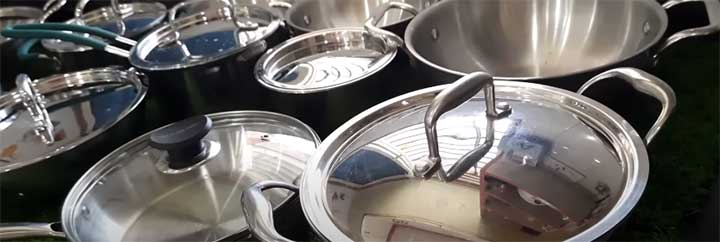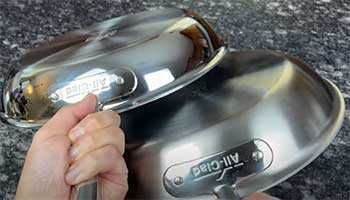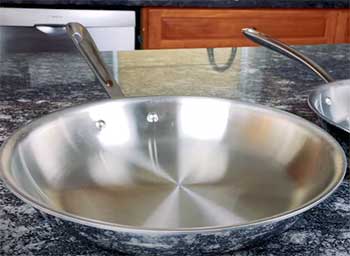When it comes to cookware, Tri-Ply and All-Clad are two of the biggest names on the market. But what exactly do these terms mean, and is one better than the other?
In this comprehensive guide, we’ll break down the key differences between Tri-Ply and All-Clad cookware, look at the pros and cons of each, and help you decide which is the right choice for your cooking needs.
A Brief Comparison Table
| Feature | Tri-Ply | All-Clad |
| Construction | Aluminum or copper core with stainless exterior | Pure aluminum core with stainless exterior |
| Heating Properties | Good heat conductivity and evenness | Excellent heat conductivity and evenness |
| Cooking Performance | Good searing and versatility | Excellent searing and versatility |
| Appearance | Varies from basic to stylish | Beautiful brushed finish |
| Lifespan | Inconsistent based on materials | Consistently durable for decades |
| Oven Safe Temp | Up to 500°F usually | Up to 600°F |
| Induction Compatible | If stainless exterior | Yes |
| Dishwasher Safe | Yes | Yes, but handwashing recommended |
| Warranty | Varies by brand | Limited lifetime warranty |
| Common Brands | Cuisinart, Calphalon | All-Clad |
| Made In | Varies | USA |
What Is Tri-Ply Cookware?

Tri-Ply refers to a construction technique that uses three layers of metal bonded together. The most common types of Tri-Ply cookware consist of:
- An inner core of aluminum or copper
- A middle layer of aluminum or stainless steel
- An exterior layer of stainless steel
The aluminum or copper inner core provides excellent heat conductivity. This allows heat to spread quickly and evenly across the bottom and up the sides of the pan.
The middle layer of aluminum or stainless steel strengthens the pan and prevents warping. It also helps distribute heat from the core layer.
Finally, the stainless steel exterior is durable, resists corrosion, and is easy to clean. It provides an elegant polished look.
Some of the most popular Tri-Ply cookware brands include All-Clad, Cuisinart, and Calphalon.
Benefits of Tri-Ply Construction
There are several key benefits that make Tri-Ply a great choice for cookware:
- Even heating: The aluminum or copper core allows heat to spread evenly across the pan, eliminating hot spots. This prevents food from burning in one area while remaining undercooked in others.
- Good heat conductivity: The conductive properties of aluminum and copper mean Tri-Ply cookware reacts quickly when heat is adjusted. Food cooks faster and more efficiently.
- Durability: The bonded stainless steel exterior holds up well to daily cooking demands and resists scratches. Tri-Ply cookware can last for many years with proper care.
- Oven and dishwasher safe: Most Tri-Ply cookware handles oven temperatures up to 500°F. The stainless steel exterior also makes it durable enough for the dishwasher.
- Works on all cooktops: Tri-Ply cookware is compatible with all types of stovetops including induction. The aluminum/stainless steel construction allows it to work on any heat source.
- Ease of maintenance: The smooth stainless steel finish makes Tri-Ply cookware easy to clean. There are also no coatings that can chip or flake off over time.
Potential Drawbacks of Tri-Ply
While Tri-Ply cookware has many advantages, there are a few potential drawbacks to consider:
- Price: Tri-Ply construction is more complex than single layer stainless steel, so it tends to be one of the more expensive cookware options. Budget-conscious shoppers may want to look at other types of pots and pans.
- Weight: The triple-layer metal build makes Tri-Ply heavier than other materials like anodized aluminum. This can make tossing foods or transferring pans more difficult.
- Sensitive to thermal shock: Sudden temperature changes can damage or warp Tri-Ply cookware. You need to preheat it gradually and avoid pouring cold liquids into extremely hot pans.
- Can discolor over time: While it resists scratches well, the stainless steel exterior of Tri-Ply cookware can start to show discoloration over years of use. This doesn’t affect performance but can detract from its appearance.
- Requires more care: To prevent food from sticking, Tri-Ply cookware may need preheating and the use of oil, butter, or other fats during cooking.
- Not ideal for browning: While it conducts heat well, stainless steel isn’t the best at browning foods. Meat and other proteins may not develop as nice of a sear as they would in cast iron.
What Is All-Clad Cookware?
All-Clad is an American company that specializes in making premium Tri-Ply cookware. The key features of All-Clad pans include:

- Tri-Ply construction with an aluminum core
- Brushed stainless steel exterior finish
- Stainless steel loop handle riveted for control and comfort
- Flared rims for drip-free pouring
- Compatible with all cooktops, oven safe up to 600°F
Rather than just a type of cookware, All-Clad is a reputable brand known for innovative designs and exceptional quality. They offer extensive cookware collections that include frying pans, saucepans, stockpots, roasting pans, and more.
All-Clad pans come with a limited lifetime warranty, underscoring their durability. While expensive initially, they can last for decades when properly cared for.
Benefits of All-Clad Tri-Ply
All-Clad Tri-Ply cookware provides all the benefits of classic Tri-Ply construction but with enhanced performance:
- Fast, even heating: The pure aluminum core quickly adjusts to temperature changes for precise cooking control. Heat spreads completely across the pan.
- Superior durability: All-Clad uses stainless steel with a higher gauge (thickness) that resists warping. The pans can withstand high heat and serious wear-and-tear.
- Elegant appearance: The brushed finish has a classy, modern look. All-Clad cookware makes an impressive addition to any kitchen.
- Oven and broiler safe: Most All-Clad pans can tolerate temperatures up to 600°F in the oven. Some can even be used under the high heat of a broiler.
- Ergonomic handles: Riveted steel handles are contoured for comfort and keep cool during stovetop cooking. They provide a secure grip even with heavy foods or liquids.
- Wide variety: With an extensive product catalog, you can find All-Clad pans ideal for searing, frying, simmering, braising, and more.
- Made in America: All-Clad cookware is handcrafted by skilled metalworkers at the company’s mill in Canonsburg, Pennsylvania.
- Lifetime warranty: All-Clad offers a limited lifetime warranty against defects in materials and workmanship. This demonstrates the durability of the cookware.
Potential Drawbacks of All-Clad
The biggest downside of All-Clad is clearly the cost. Their cookware sits at the higher end of the price spectrum. Budget-minded shoppers may find All-Clad out of reach.
A few other disadvantages to note include:
- Heavier weight: The thick, tri-ply construction makes All-Clad one of the heaviest-duty options around. While this aids durability, it requires more strength and care when handling.
- Prone to sticking: The stainless steel cooking surface can be slow to develop a natural patina. Food may stick at first until properly broken in.
- Metal utensil safe only: You need to use metal spoons, whisks, etc. to avoid scratching the cooking surface. Silicone or plastic utensils won’t damage other types of cookware.
- Requires maintenance: Hand washing is recommended to preserve the brushed stainless finish. Leaving pans to soak can allow food debris to bake on.
- Loud: All-Clad’s solid metal build retains sound. Pans and lids can make loud noises from thermal shock or if handled too aggressively.
Directly Comparing Tri-Ply and All-Clad
Now that we’ve explored the pros and cons of Tri-Ply cookware in general and All-Clad specifically, let’s directly compare the two:
Construction
- Tri-Ply refers to a three-layer build with an aluminum or copper core, while All-Clad uses aluminum exclusively.
- All-Clad Tri-Ply tends to use higher gauge metals that improve durability.
- Generic Tri-Ply options vary more widely in quality of materials and construction technique.
Heating Properties
- Both Tri-Ply and All-Clad heat quickly and evenly across the pan.
- All-Clad’s pure aluminum core may have a slight performance advantage for conductivity.
- But any high quality Tri-Ply will cook food evenly with minimal hot spots.
Cooking Performance
- Tri-Ply and All-Clad can both sear, sauté, fry, simmer, and more.
- All-Clad’s superior craftsmanship gives it an edge for cooking precision.
- Generic Tri-Ply quality has greater variability. Poor bonding can reduce heat flow.
Appearance and Design
- All-Clad features a stylish brushed finish and comfortable handles.
- Less expensive Tri-Ply tends to have a less attractive polishing and basic handles.
- But cosmetics don’t affect cooking ability. You pay more for All-Clad’s looks.
Price
- High quality Tri-Ply costs less than All-Clad, sometimes significantly so.
- But lower priced Tri-Ply often reflects lower materials quality and construction standards.
- All-Clad delivers exceptional performance that justifies the investment for serious cooks.
Lifespan
- Generic Tri-Ply lifespan can vary greatly depending on materials and bonding quality.
- All-Clad lasts for decades with proper care. The warranty provides peace of mind.
- But well-made Tri-Ply with heavy gauge metals can last just as long as All-Clad.
So in summary, All-Clad represents the pinnacle of Tri-Ply cookware, with superior heating, precise cooking control, and proven longevity. Other Tri-Ply can potentially match All-Clad’s performance, but lower quality versions may disappoint.
Choosing the Right Cookware for You
When deciding between All-Clad and other Tri-Ply cookware, consider these factors:

- How often will you use it? All-Clad is worth the money if you cook frequently. Occasional cooks can get by with less expensive Tri-Ply.
- What’s your budget? All-Clad costs significantly more than most Tri-Ply. Make sure to get the best quality Tri-Ply you can afford.
- What do you cook most? All-Clad excels at finicky tasks like frying eggs or searing meat. For simple boiling or simmering, basic Tri-Ply works fine.
- What pieces do you need? Fill your core cookware needs with All-Clad (frying pan, saucepan, stockpot). Then supplement with generic Tri-Ply.
- How important is appearance? All-Clad looks beautiful. If you want restaurant-level aesthetic, the premium price tag is justified.
- Do you cook on induction? All-Clad’s stainless steel construction makes it induction compatible. Some less expensive Tri-Ply uses aluminum exteriors that won’t work on induction.
Recommended All-Clad and Tri-Ply Cookware
Here are some top options to consider in All-Clad and Tri-Ply cookware:
All-Clad Tri-Ply
- All-Clad D3 Stainless 10-Piece Cookware Set – Versatile mid-priced starter set. Great for everyday cooking.
- All-Clad D5 Brushed 5-Ply Stainless Steel Set – Top of the line with extra layers for optimal heat diffusion. Handles high heat beautifully.
- All-Clad HA1 Hard Anodized Set – Budget-friendly All-Clad line. Still exceptional quality but costs less than stainless.
- All-Clad Copper Core 5-Ply Set – The ultimate All-Clad cookware with a copper core for incredible responsiveness.
Tri-Ply Alternatives
- Cuisinart MultiClad Pro Set – Great mid-priced Tri-Ply option comparable to All-Clad’s low-end.
- Tramontina Tri-Ply Clad Stainless Steel Cookware Set – Cost effective starter bundle with decent quality.
- Calphalon Tri-Ply Stainless Steel 10 Piece Set – Similar performance to All-Clad but much cheaper. Budget workhorse cookware.
- Demeyere Industry5 Stainless Steel Cookware – High-end Belgian brand rivals All-Clad quality for less cost.
Frequently Asked Questions (FAQ)
Tri-ply and clad are the same thing. Clad is a shorthand way of saying “clad-metal” which refers to the process of bonding multiple layers of metal together. So Tri-Ply construction means three clad or bonded layers of metal.
Tri-ply is generally better than single layer stainless steel. The aluminum or copper core in tri-ply allows for better heat distribution. Stainless steel alone can have hot spots that lead to uneven cooking. The only advantage of stainless is potentially lower cost.
Tri-ply is worth it for most home cooks. The multi-layer metal construction offers durability, even heating, and good performance at high heats. While more expensive than stainless, it will last much longer. The extra cost translates to better cooking ability in most cases.
Tri-ply is among the best general purpose cookware constructions. It’s not the absolute best at everything – cast iron holds heat better, and specially coated non-stick pans are more slippery. But for a material that works well for most cooking tasks, combines durability and performance, and works on all stove types, tri-ply is hard to beat for the average cook.
Closing Remarks
Both Tri-Ply and All-Clad offer excellent cooking performance thanks to their aluminum or copper cores that distribute heat quickly and evenly. All-Clad is widely regarded as the highest quality Tri-Ply cookware, with superior materials, construction, longevity, and aesthetic appeal.
However, it comes at a steep price premium. Less expensive Tri-Ply from brands like Cuisinart and Calphalon can match much of All-Clad’s cooking ability for a fraction of the cost.
Ultimately, All-Clad justifies its price for serious home cooks who use cookware daily and value top-tier performance and longevity.
More casual cooks can likely get by with quality Tri-Ply alternatives and save considerably. But no matter which you choose, Tri-Ply and All-Clad both represent smart investments in cookware that can significantly elevate your cooking.

